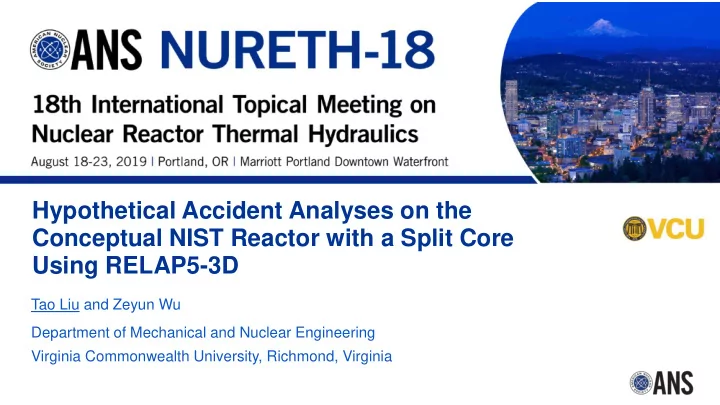

2018 International Congress on Advances in Nuclear Power Plants Hypothetical Accident Analyses on the Conceptual NIST Reactor with a Split Core Using RELAP5-3D Tao Liu and Zeyun Wu Department of Mechanical and Nuclear Engineering Virginia Commonwealth University, Richmond, Virginia
Contents ▸ Conceptual NIST Reactor ▸ Computational Models ▸ Results Comparison ▸ Conclusion and Future Work 1 2
Proposed NIST Reactor • Tank in pool reactor • 20MW thermal power and 30-day operating cycle • Low enriched uranium (LEU) – U 3 Si 2 -Al • Cooled by forced downward circulation • Moderated by heavy water 2
Research background and Purpose Preliminary neutronics and T/H safety analyses have been performed. • Neutornics: Monte Carlo code MCNP. • T/H Safety analyses: Modular channel code PARET. To overcome computational modeling limits, RELAP5-3D will be used. • Nodalization of the core and other important components of PCS. • Comparison study of the system behavior predicted by both T/H codes. 3
Reactor Core Model in the Relap5-3D Boundary Conditions Upper and bottom plenum • Time-dependent control • Branch volumes and junctions Hydrodynamic channels Fuel element • Hot, average and bypass • Heat structures channel • Divided into 17 control volumes 4
MTR Fuel Element and Flow Channel Modeling 5
Key Parameters for RELAP5-3D Model Values Materials Thermal-hydraulics Values Fuel thermal conductivity (W/ m·K ) Fuel meat material U 3 Si 2 -Al 48 Fuel type Plate type Cladding thermal conductivity (W/ m·K ) 180 Fuel volumetric heat capacity (J/m 3 ·K) Fuel density (g/cc) 6.53 2.225E+6 Cladding volumetric heat capacity (J/m 3 ·K) Enrichment (wt%) 19.75 2.419E+6 U-235 loading (g/plate) 391.47 Inlet coolant temperature (°C) 37 Core outlet pressure (kPa) 200 Total power (MW) 20 Values Fuel assembly geometry Inlet volumetric flow rate (gpm) 8000 Hydraulic diameter (cm) 0.56 Fuel assembly 18 Fuel plates per assembly 17 Aluminum plates 2 Fuel plate width (cm) 6.665 Fuel meat width (cm) 6.134 Fuel plate thickness (cm) 0.127 Values Fuel meat thickness (cm) 0.066 Reactor kinetics Cladding thickness (cm) 0.0305 Prompt neutron generation time (µs) 252.63 Fuel plate length (cm) 60 Effective delayed neutron fraction (β eff ) 0.00718 Fuel meat length (cm) 67.28 6
Temperature Comparison in Start-up (SU) Hot Channel Average Channel Deviation Deviation RELAP5 PARET RELAP5 PARET 1.22% 0.90% 108.05 109.38 82.52 83.27 T (Fuel) 1.05% 0.85% T(Cladding) 97.91 98.95 76.25 76.90 0.21% 0.15% 48.11 48.01 46.56 46.49 T(Outlet) 4.98% 4.86% MCHFR 3.300 3.473 5.379 5.654 7
Temperature Comparison in End of Cycle (EOC) Hot Channel Average Channel Deviation Deviation RELAP5 PARET RELAP5 PARET 1.22% 0.86% T (Fuel) 96.94 98.14 73.80 74.44 1.00% 0.68% 89.20 90.10 68.96 69.43 T(Cladding) 0.15% 0.09% T(Outlet) 53.74 53.66 46.54 46.50 6.00% 4.84% MCHFR 4.060 4.319 6.894 7.245 8
Slow Reactivity Insertion Accident (SRIA) • A positive reactivity is gradually inserted into the initially critical reactor at the low power of 2 Watts (0.01% of full power). • The reactivity insertion rate is assumed to be 0.1$/s to mimic a ramp reactivity insertion condition. • The reactor scram occurs at the power of 24 MW (120% of full power) with a high reactor power trip signal. • To take into the account of the operation time delay due to the mechanical and electronic circuit effects, a delay of 25 ms is imposed to the control rod reaction after the trip. • All reactivity feedback effects and period trip are neglected in the analyses. 9
Power and peak cladding temperature changes in SRIA. Core Status RELAP5-3D PARET Deviation Peak power [MW] 30.68 30.66 0.07% 11.81 11.79 0.17% Peak power time [s] Reactor trip time [s] 11.79 11.75 0.34% 10
Comparison of temperature changes in SRIA Core Status RELAP5-3D PARET Deviation 103.58 108.93 4.91% Peak clad temperature [°C] 11.85 11.82 0.25% PCT time [s] Peak fuel temperature [°C] 113.73 120.41 5.55% 11.85 11.82 0.25% PFT time [s] 11
Large Reactivity Insertion Accident (LRIA) • A step positive reactivity(1.5 $) is inserted into an initially critical core in 0.5s at full power to mimic the control rod abnormal accident during the reactor normal operation. • The reactor scram occurs at the power of 24 MW (120% of full power) with the high reactor power trip signal. • A time delay of 25 ms is considered and the control rods are assumed to be inserted with a speed of 1.2 m/s for reactor trip. • All reactivity feedback effects and period trip are neglected in the analyses 12
Power and peak cladding temperature changes in LRIA. Core Status RELAP5-3D PARET Deviation Peak power [MW] 26.47 26.51 0.15% 0.13 0.13 0.00% Peak power time [s] Reactor trip time [s] 0.01 0.01 0.00% 13
Comparison of temperature changes in LRIA Core Status RELAP5-3D PARET Deviation Peak clad temperature [°C] 99.96 102.58 2.55% 0.17 0.16 6.25% PCT time [s] Peak fuel temperature [°C] 109.57 112.68 2.76% 0.16 0.16 0.00% PFT time [s] 14
Conclusions and Future Work • The RELAP5-3D model to predict the thermal hydraulics properties of the conceptual NIST research reactor core was established. • Both steady-state and reactivity insertion transient calculations were performed. • Preliminary results produced by the RELAP5-3D have a good agreement with the ones from the PARET code, which verifies the correctness of the current model in a certain degree. • In the next stage, some additional components in the primary cooling system of the reactor, such as heat exchanger and primary loop pump, will be developed in the RELAP5-3D model • More design basis accident analyses such as the loss of flow accident (LOF) will be performed using the RELAP5-3D model. 15
Thank you!
Recommend
More recommend